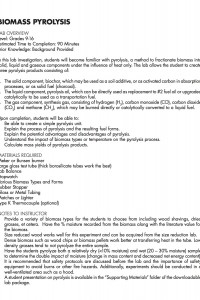The video above provides a full tutorial of the Biomass Pyrolysis lab.
In this lab investigation, students will become familiar with pyrolysis, a method to fractionate biomass is split into solid, liquid and gaseous components under the influence of heat only. The lab allows the student to create three pyrolysis products consisting of:
- The solid component, biochar, may be used as a soil additive, or as activated carbon in absorption processes, or as solid fuel (charcoal)
- The liquid component, pyrolysis oil, which can be directly used as replacement to #2 fuel oil or upgraded catalytically to be used as a transportation fuel
- The gas component, synthesis gas, consisting of hydrogen (H2), carbon monoxide (CO), carbon dioxide (CO2) and methane (CH4), may be burned directly or catalytically converted to a liquid fuel
Learning Objectives
Upon completion, students will be able to:
- Create a simple pyrolysis unit
- Explain the process of pyrolysis and the resulting fuel forms
- Explain the potential advantages and disadvantages of pyrolysis
- Understand the impact of biomass types or temperature on the pyrolysis process.
- Calculate mass yields of pyrolysis products
| Download the Full Package |
Concepts/Skills
Combustion, Phase Changes, Vaporization, Energy Content
Prior Knowledge
Background provided
Time Required
90 minutes
Required Supplies
Meker or bunsen burner, large glass test tube, lab balance, stopwatch, various biomass types and forms, rubber stopper, glass or metal tubing, matches/lighter, type K thermocouple (optional)

